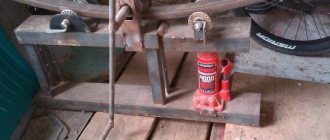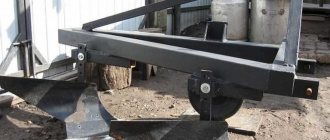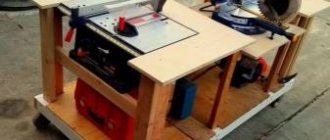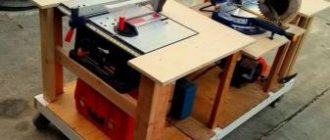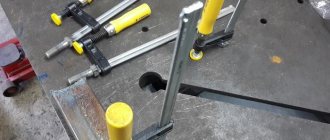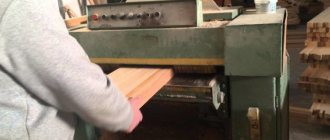DIY carpenter's table
If the main tools of a blacksmith are a hammer and an anvil, then for a carpenter there is nothing “more familiar” than his workbench.
For people who work with wood, it can at the same time be a cutting platform and an assembly table, a stop and stand, a device for storing tools and even, if you want, a small carpentry machine, and sometimes a means of earning money. This article tells you how to make woodworking tables with your own hands. The instructions, photographs and drawings presented in it will help even a beginner to install this structure. First of all, after building a workshop, you need to make yourself a table. A table like a workbench, essentially. This is a table for work - fitting, assembling small things made of wood (stools, shelves, etc.). I'll call it an assembly table.
In fact, the second name for a workbench is an “assembly table.” But, as you already understand, its purpose goes far beyond assembly operations. Therefore, the design of a multifunctional workbench in a carpentry can be quite intricate (see drawing below), and its development (in the absence of experience) can be spent as much time as it takes to design the carpentry workshop itself.
How to make a stand for a drill?
Making a mini-drilling machine with your own hands does not require high qualifications, but it greatly expands the scope of application of an ordinary electric drill. In addition, the machine will be much cheaper than a purchased one, and components can be borrowed from previously used devices.
Making a wooden stand will take very little time and will not require any special materials or tools:
- wooden blocks or boards no thinner than 20 mm;
- furniture guides;
- metal rod with thread for caliper;
- fasteners for wooden parts (screws, glue);
- emery.
Tools:
- hacksaw;
- vice;
- Screwdriver Set;
- electric drill.
Making a stand from metal requires a little more time and materials, so it is necessary to cover it in a little more detail.
The proposed metal stand is more versatile than one made of wood and includes:
- supporting frame;
- guide posts of the drill, to which it is attached and moved vertically;
- vertical tool feed handle;
- additional components for ease of use.
General description of the carpentry workbench
At the heart of any carpentry workbench, regardless of the number of operations that are supposed to be performed with its help, there is always an ordinary wooden table. It is on it that the master will do carpentry, drill parts, process surfaces, assemble wooden trinkets into one complex structure and surprise others with his skills.
A good solid table is the basis. And everything else - vices, clamps, boxes with tools and fasteners - all these are constant attributes of the most useful tool in a carpentry workshop.
Workbench project
To make a carpentry workbench with your own hands, you must first understand its parameters that are optimal for you.
The dimensions of the workbench for work are chosen in such a way that you can work while standing at full height and without slouching. For a person of average height, the height of the table should be within 70...90 cm. But it is better to focus on the features of your own anatomy. It is optimal if the upper cut of the legs is at the level of your lowered arms. When a few centimeters are added to this height (the thickness of the workbench lid), you will understand that working while standing at such a table is a pleasure.
It is better to make the workbench cover, as well as the working surface, from solid wood or plywood. There are people who use particle board materials, light chipboard sheets, etc. for these purposes. We strongly do not recommend that you follow their example. This is a bad design - after all, the loads on the surface of the structure can be quite noticeable, and the particle board under such conditions will quickly fail.
5 years ago I received 2 sheets of plywood as a gift from a neighbor. It was decided to use it in the construction of a workbench. The size of the workbench was determined immediately - it was a pity to cut such a sheet. Experience has shown that there are no extra centimeters at the table. The height was determined by the height of the palms from the floor and amounted to 850 mm.
Ideally, a homemade workbench should have a special tray on the lid for storing tools and wood pieces involved in the work, as well as special holes (sockets) for wedges and combs. Using wedges and (or) combs, parts and workpieces will be secured to the table surface. It is on the cover that auxiliary clamps (vises) should be mounted to fix the processed lumber.
The dimensions of the workbench may vary depending on the size of your workshop. But, as practice shows, the optimal dimensions of the lid are 700 mm wide and 2000 mm long.
The supports (legs) of the workbench can be made from wooden beams 120*120 mm, no more. This will be quite enough to ensure that the structure is stable and does not become loose under the influence of brute physical force.
How and from what to make
The most affordable and practical material is wood and its derivatives. Plywood, chipboard, fibreboard, OSB, countertops from already unnecessary tables, etc. will be a completely reasonable choice.
It is important to consider:
- if work is carried out in a damp room, it is necessary to choose a material that is protected from moisture - laminated, impregnated, followed by varnish/paint treatment;
- the working surface should be as flat and smooth as possible. Using boards of different thickness/texture/treatment will not allow you to obtain such a surface, so for the tabletop it is better to use a solid slab of plywood or wood board;
- guides and racks should be made of the same type and size of material, except in cases where the load is distributed unevenly and some of the racks require reinforcement;
- connections of wood materials are made using fasteners (screws, bolts, screws, confirmations) and glue, as well as a tongue-and-groove or tongue-and-groove system. The adhesive type of connection requires waiting for the glue to dry completely; in critical places, it is better to duplicate the gluing with metal fasteners.
It is necessary to assemble a workbench in a wooden garage with your own hands in a fairly dry and well-ventilated room - dust from sawing and sanding materials, fumes from varnish/paint must be removed quickly.
Important: since the load on the tabletop is often very large and uneven - for example, only on one corner - it must be reinforced by a frame or supports located under the main plane.
Workbench installation
As practice shows, making a workbench is not difficult. Installing a workbench is no different from assembling an ordinary wooden table. The vertical supports are fastened together using vertical boards and self-tapping screws. The working surface should also be secured to the supports using self-tapping screws.
In order to save space in the carpentry workshop, some craftsmen make a homemade workbench folding. It is mounted on the wall. This type of installation means that carpentry work will only be carried out when necessary.
In the past, in cramped conditions, I had a workbench board - a laminated MDF board 24 mm thick, with dimensions 1200x2200. It had minor modifications, such as: holes and grooves for attaching a hand router and circular saw, a flush-mounted metal frame with threaded holes for attaching rulers, and mustache nuts at the bottom, located in the places where the hand plane and drilling machine from a drill with a rocker are attached. The tabletop was attached to the wall on three hinges. During non-working hours, it was raised vertically and fixed to the wall. Under the board, also on hinges, are two triangles from the same board. She laid herself on them while working.
Advantages of folding design
The collapsible table is compact in size. The transformer is made primarily of metal and fiberboard. The metal frame is designed to withstand high loads. Some metalworking and carpentry workbenches have special mounts for mounting various equipment manufactured to increase functionality. Such equipment could be:
Circular plate. A circular saw will be almost indispensable in a home workshop. A similar circular saw is used to divide a workpiece into several parts in the longitudinal or transverse direction.- Grinder machine. To give the surface the required qualities, the surface layer is removed. The roughness can be changed by using a grinding wheel with different abrasive grains.
- An electric jigsaw is used to produce products with different geometric shapes.
- Drilling machine. To produce holes of various diameters, drilling units are used, in the spindle of which a drill or cutter is placed.
When using the design, processing can be carried out with high precision, as in a production workshop. All installed equipment can be removed if not required. The advantages of a folding workbench include:
- Its use allows you to save free space.
- Although the supporting structure can be transformed, it has quite high strength. Some models can withstand about 200 kg.
- Modern countertops are made in such a way that the workpiece can be securely fastened. For this purpose, use the clamps that are included in the kit. If necessary, you can purchase them separately.
In cases where it is necessary to bend and cut thick metal, a folding structure will not be suitable. The moving parts can withstand planing and sawing, as well as cutting and other machining. If the models that are on sale do not fit, then you can make a table according to your own plan.
Rear and front clamps
Rear and side (front) screw clamps are those elements without which no workbench simply can fulfill its main purpose. Therefore, this part of the structure should be built first.
The rear clamp is designed to hold lumber while planing. As shown in the diagram, its vice blocks move along the front edge of the workbench, allowing the workpiece to be securely secured using lead screws.
The side screw clamp (which, due to its special location, is called the front clamp by many) has the same purpose as the rear clamp. And these elements differ from each other only in their location. Here are the drawings of a carpentry table for making it yourself.
Advantages of the folding system.
- The working surfaces of this design are ergonomic and compact. When folded, they practically do not occupy any useful space.
- Multifunctionality. A folding table is used not only for production activities and performing assembly and plumbing work, it is very convenient as a temporary stand for various parts, units and tools, taking notes, eating and resting.
- Simplicity and ease of use.
- No difficulties in self-manufacturing and installation.
Podverstache
In the conditions of a large accumulation of individual cabinets, carpentry machines and additional accessories in the carpentry, it would be simply a crime not to use the free space under the workbench with maximum benefit for yourself. Therefore, creating a massive base (underbench) in the space under the upper plane of the workbench is a convenient technique that many craftsmen have long neglected when creating additional conveniences.
The fact of the matter is that in the design of a workbench, a lower shelf is absolutely necessary (especially on a mobile workbench). We use a lot of tools and have nowhere to put them outside while working. And it’s also inconvenient in the workshop - climbing back and forth on cabinets and shelves. Fold the same tool 10 times per hour.
The underbench can be adapted for storing power tools. For greater convenience, you can install cabinets and shelves here for small parts, fixtures and hand tools.
Having made a workbench that has all the listed elements, you can begin your carpentry activities. In the process of further work, you may need additional devices. But each master will be able to guess for himself what options to use and what elements to add.
You can learn how to properly dry wood, from which you can later make various products on your carpentry workbench, from our previous article. You can get acquainted with practical ideas regarding creating a carpentry workbench in the corresponding section of our forum. Any FORUMHOUSE visitor can become familiar with the rules and features of using a hand-held circular saw by visiting a special topic created for discussion.
How to make a folding workbench with your own hands?
- Peculiarities
- Required tools and materials
- Recommendations
DIY folding workbench is a “mobile” version of the classic workbench. It's quite easy to make it yourself. The basis for a homemade workbench is a drawing developed taking into account the types of work (installation, plumbing, turning and others).
Types of workbenches depending on the type of work and available space
Taking into account exactly how the DIY workbench will be used in the garage, you need to select the desired configuration:
- landline or mobile;
- with a fixed, permanent tabletop, or folding;
- with additional shelves/drawers/holders and other storage places or simplified, in the form of a table;
- straight, angular or U-shaped;
- free-standing or mounted near a wall.
Since space is usually not enough, it is better to plan a stationary workbench with your own hands near the wall, and place it in a corner or in the least used place in the garage or workshop.
Important: if the room has windows or a ventilation outlet, a draft is possible - you should not place the workplace in its path, otherwise problems with the back, neck and muscles heated during work are guaranteed.
A mobile folding workbench, made with your own hands from scrap materials, can be kept anywhere, and can be pulled out to a suitable place during use.
Before selecting a specific model and choosing its dimensions, it is advisable to estimate the amount of equipment and tools you already have or are planning to purchase - it is better to make a workplace “for growth” than to suffer in trying to attach additional devices to already crowded shelves.
Peculiarities
A folding workbench when folded takes up to 10 times less space than when working.
Portable - a version whose operating principle is similar to a folding chair or a regular extendable table that is easy to carry. The disadvantage is the almost complete absence of drawers, which noticeably weigh down the structure: instead of them there are one or two shelves without back walls, the workbench itself resembles a rack.
Universal - a structure that is attached to the wall, but unlike a regular wall-mounted table, this table has all four legs. The scheme is complicated by retractable wheels, allowing you to use the workbench as a cart. This version is reminiscent of a mobile table for preparing hot dogs, popular among fast food sellers in the 90s of the last century: there are shelves with back walls (or full-fledged drawers). It can be folded against the wall, lifted and secured, and rolled to another place. Carrying requires the help of two more people: the weight is significant - tens of kilograms.
Required tools and materials
When making a workbench for a home or apartment, a hand-crafted plumbing set is used: a hammer, a universal screwdriver with different attachments, pliers, a plane, a hacksaw. Power tools will significantly speed up the work - a drill with a set of drills, an angle grinder with a cutting disc for wood, a screwdriver with Phillips and flat bits, a jigsaw and an electric plane.
The materials you will need:
- board (timber) with a thickness of at least 4 cm - these are used for lining a rough or finished floor;
- plywood sheets - their thickness is at least 2 cm.
Chipboard and fiberboard are not suitable - they will not withstand a significant load: with a pressure of at least 20-50 kg per square centimeter, both sheets will simply break.
Natural wood is a must. The best option instead of plywood is also a single-layer board with a thickness of at least 2 cm. Use hardwood - soft wood will wear out quickly.
You will also need fasteners.
- Bolts and nuts with lock washers - their size is at least M8. Stud lengths are allowed.
- Self-tapping screws – with a diameter of at least 5 mm (external thread size). The length should be such that the self-tapping screw almost reaches the back of the boards being fastened, but its tip does not show or be felt to the touch.
- If the workbench is made with wheels, you will need furniture casters, preferably all-steel ones.
- Furniture corners.
An even better result can be achieved by using wood glue together with the corners - for example, “Moment Joiner”, recommended for gluing natural wood and lumber.
Tool cabinet in the garage
This bedside table will serve both for performing a variety of tasks and for storing tools. It will take up very little space in the garage, and if you try, its pleasing appearance will decorate the room.
- First you need to draw up a plan diagram of such a bedside table. You can choose the proposed option, or based on it you can design your own, taking into account all your personal wishes for the arrangement of the workplace.
- For a novice carpenter, it will be useful to build a bedside table for storing working tools. This will allow you to acquire the necessary experience in carpentry and build the mini-workshop necessary for full-fledged work, which will fit in a small wooden box.
- The proposed tool cabinet in this case is a small floor cabinet. Inside it is equipped with nests for storing various tools, and outside it has a workbench board. It is made from plywood boards or boards 20 mm thick. The bench board must be carefully trimmed and trimmed.
The tool cabinet is equipped with two drawers: one hinged on the door, the other pull-out - the number of drawers and their functionality can be any depending on your needs. The top of the bedside table is equipped with a hinged lid in the form of a drawer. The lid is attached to the frame with hinges. In the working position, it can be folded back and leaned against the wall, or it can be equipped with holders so that it independently remains in a given position. When not in use, the lid will simply lower and close the bedside table.
To make the frame of the bedside table, you need to use either bars or boards with a cross section of 1.5 X 2 cm. The product can be lined with plywood or wood board.
The device for keeping tools in the cabinet is made at your own discretion.
- As you can see in the photo, this garage furniture is either painted or covered with film. You can use a transparent finish, but this will require more painstaking carpentry preparation of the product.
- The interior decoration can be simple; it will be enough just to carefully and repeatedly sand the parts from the inside or paint them with varnish or light-colored paint.
- Materials for assembling a workbench. Total cost of the workbench.
- To assemble a workbench you will not need a lot of materials with a total cost of 3 to 3.5 thousand rubles, depending on the place of purchase. For reference, prices from the Leroy Merlin store in the Moscow region will be indicated.
Lumber
- Planed block 30x40x2000 needles - 1 pc. (68 rub.)
- Planed board 40x96x3000 needles - 5 pcs. (1610 rub.)
- Planed board 20x96x3000 needles - 4 pcs. (620 rub.)
- Layout 14x14x2100 needles - 1 pc. (70 rub.)
Fasteners
- Bolt with nut and two washers M8x100 - 16 pcs. (416 rub.)
- Drywall-wood screws 3.5x45 200 pcs. — 1 box (147 rub.)
- Drywall-wood screws 4.2x90 6 pcs. — 3 packs (42 RUR)
- Furniture dowel 10x50, wood, beige, 30 pcs. — 1 package (47 rub.)
- Reinforced mounting angle 40x40x40x1.5 - 4 pcs. (52 rub.)
- Waterproof PVA glue D3 Tytan 200 g - 1 bottle (151 RUR)
Manufacturing process
Hardwood plywood, for example birch, with a thickness of at least 1.5 cm, may also be suitable as a base material.
Base
Making a base box involves a number of steps.
- Mark and cut a plywood sheet (or several sheets) according to the drawing.
- The base is a box with drawers. For example, its dimensions are 2x1x0.25 m. Connect the sidewalls, back wall and partitions for the boxes with the underbench (the lower wall of the supporting box).
- For the resulting drawer compartments, assemble the drawers - it is advisable to do this in advance. The external size of the drawers is slightly smaller than the internal dimensions of the compartments for them - this is necessary so that they slide in and out without effort. If necessary, install guide spacers. Also install handles on the drawers in advance (you can use handles for doors, cabinets, wooden windows, or others).
- Place the top wall on the box. This is not a tabletop yet, but a base on which it will be installed.
- Using a jigsaw and sander, round off the leg pieces where each leg forms a knee.
- Install the leg strips in the center of the supporting structure, without deviating from symmetry. For example, if the length of the legs is 1 m, then their main and counterpart parts can be half a meter long (not counting the roller mechanisms). The width of the legs can reach up to 15 cm, thickness - according to the number of layers of plywood.
- Attach rotating casters from the Joker brand furniture designer to the bottom of the main box. They are placed on size 10 bolts and give the structure the functionality of a transformer.
- Install the mating parts of the legs on the furniture bolts. Perform a test assembly and check that they operate correctly. To prevent loosening of each “elbow”, large washers are installed (grip washers can be used).
- To avoid any difficulties when unfolding, synchronizing bars are installed on the moving parts - like those that are placed on the upper and lower passenger seats, folding tables in train cars. They make it possible to quickly fold and unfold the workbench without unnecessary movements.
The workbench is ready for further modification.
Preparing tool boxes
I wanted a little storage underneath the countertop for hammers, pliers, drills, and chisels. To do this, I purchased a large tool box with two pull-out sections.
First, I cleaned off the old paint from the boxes - army camouflage was not part of my plans. And then I attached them under the tabletop. I also prepare the vice for installation - I clean off all the grease from it, then wipe it dry and mark the attachment points to the tabletop. I drill holes for the screws and screw the vice to the workbench.
Recommendations
For clearer contact, the contact points between the parts are coated with wood glue. Strengthen glued joints using ready-made furniture corners or cut-off corner profiles. Strengthen corner joints where there is no contact with the drawers using triangular spacers.
It is advisable to immediately mount an extension cord with several sockets on the finished workbench - they will be needed to operate some power tools.
A folding workbench is hardly intended for heavy work such as assembling windows and doors. It makes turning operations difficult to produce massive parts weighing dozens of kilograms. For “heavy” work, it is better to assemble a stationary wooden workbench that can withstand a weight of more than one hundred kilograms.
Regardless of how long the workbench is, it can be foldable (including a transformer). A one-room apartment or a small country house of 20-30 square meters is unlikely to allow you to place a stationary workbench that cannot be folded. Be guided primarily by the square footage of the living space. The same advice applies to an outside utility room or garage.
Do not use plywood less than 15 mm thick or made from soft wood types for the tabletop. Such a workbench is only suitable for sewing work or activities that do not require the use of brute physical force.
Do not work on a workbench with strong reagents, especially if there is frequent splashing. For chemically active work, special tables and stands, for example, made of glass, are used.
The video below provides step-by-step instructions for one of the DIY folding workbench options.
Common brands
There are quite a large number of different models on sale, designed for use in the home workshop. The most popular ones are the following:
- Wolfcraft Master 600 is a workbench with increased stability, which does not allow play during operation. When creating a tabletop, a thick sheet of chipboard is used. The model allows the use of mechanical or electric tools. The only drawback is the lack of a limiting edge tape.
- Enkor 14218 is a multifunctional professional equipment that is designed for processing workpieces made of various materials. The tabletop can be used for processing round workpieces; it consists of two parts. Each half of the work surface can be located at an angle of 45 or 90 degrees. Special holes allow for mounting various processing equipment.
- Enkor 14220 is a workbench model with the ability to adjust the location of the working surface in height and inclination. The tabletop is made of chipboard. There are special holes for plastic stops.
- Bosch PWB 600 is a model that provides high operational safety. No special tools are required to assemble the workbench. A special feature of the model is that there is space on the work surface for storing improvised items. The tabletop is made of bamboo. When fastening oversized parts, you can use special fixing blocks, which are included in the delivery set. The supporting structure is made of aluminum profile. The design folds easily and does not take up much free space.
- Black&Decker WM 825 is an offer from a German manufacturer, equipped with a synchronization system that allows you to fix the workpiece with only one hand. To increase the comfort of working with long lumber, you can use a special vertical clamp. In the manufacture of the supporting frame, metal is used, which has increased protection from environmental influences.
- KETER 38730 is a folding workbench that is lightweight and compact in size. For transportation you can use a convenient handle. When folded, the thickness of the structure is only 110 mm, making it easy to store. It takes no more than a minute to assemble the workbench. To secure the workpiece, special clamps are used, which are included in the delivery kit. The structure can withstand a load of about 450 kg.
Industrial versions are quite expensive. However, it depends on the functionality of the device and the popularity of the brand under which it is produced. Therefore, it is recommended to purchase ready-made workbenches if mass production is being established. If work is carried out rarely, then you should make the structure yourself.
DIY folding mobile workbench
Don't have enough space in your home workshop to accommodate a workbench? Don't rush to despair.
Find out how to make a folding mobile workbench with your own hands from inexpensive materials that can be easily found in any hardware store.
Actually, for the work you only need boards and plywood, and hinges with self-tapping screws. To make the table mobile, you will need to buy wheels.
If you already have all the basic materials at hand, then let's not waste time - let's start making a folding workbench.
The first step is to cut the pieces to the required length. To avoid confusion, you can refer to the workbench drawing.
Main stages of work
Now it will be necessary to make two side parts of the workbench on which the tabletop will rest. And which, in fact, are the legs of the table.
The author screws the doors and halves of the upper and lower drawers to the side parts, which will connect the two side panels to each other.
At the next stage, it is necessary to connect the halves of the drawers using loops, and also install the fixing latches on their reverse side.
Then all that remains is to screw the wheels to the legs, thanks to which the homemade workbench will become mobile - it can quickly be moved to any part of the workshop. Two wheels must have brakes.
You can watch the video for details on how to make a folding mobile workbench with your own hands.

